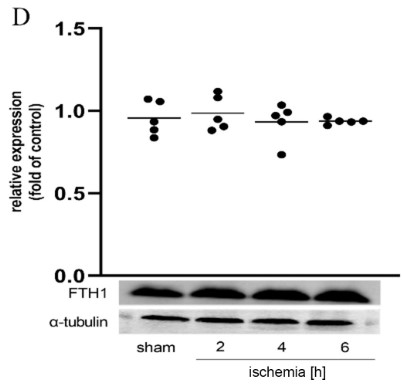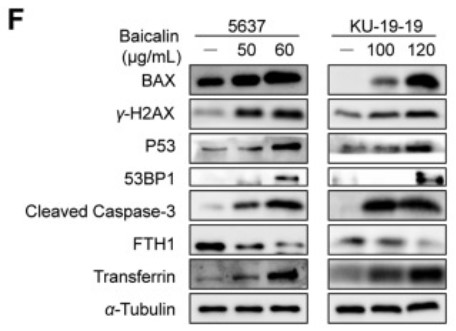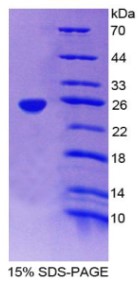FTH1
-
Official Full Name
ferritin, heavy polypeptide 1 -
Overview
This gene encodes the heavy subunit of ferritin, the major intracellular iron storage protein in prokaryotes and eukaryotes. It is composed of 24 subunits of the heavy and light ferritin chains. Variation in ferritin subunit composition may affect the rates of iron uptake and release in different tissues. A major function of ferritin is the storage of iron in a soluble and nontoxic state. Defects in ferritin proteins are associated with several neurodegenerative diseases. This gene has multiple pseudogenes. Several alternatively spliced transcript variants have been observed, but their biological validity has not been determined. [provided by RefSeq, Jul 2008] -
Synonyms
FTH1;ferritin, heavy polypeptide 1;FHC;FTH;HFE5;PLIF;FTHL6;PIG15;ferritin heavy chain;apoferritin;ferritin H subunit;placenta immunoregulatory factor;proliferation-inducing protein 15;cell proliferation-inducing gene 15 protein
Recombinant Proteins
- Human
- Mouse
- Rhesus macaque
- Rat
- Chicken
- Sheep
- Pig
- Horse
- S.cerevisiae
- E.coli
- Mammalian Cells
- HEK293
- Spleen
- HeLa
- Human Placenta
- In Vitro Cell Free System
- Non
- GST
- His
- T7
- Avi
- Fc
- DDK
- Myc
- Flag
Background
What is fth1 protein?
FTH1 (Ferritin Heavy Chain 1) protein is a subunit of the ferritin protein complex, which plays a crucial role in iron storage and transportation within cells. Ferritin is a large globular protein composed of 24 subunits, including heavy (H) and light (L) chains that form a hollow sphere capable of storing up to 4,500 iron atoms. FTH1, specifically, represents the heavy chain subunit. It is primarily expressed in the liver, spleen, and bone marrow, where it helps maintain iron homeostasis by storing excess iron in a non-toxic form.
Additionally, FTH1 is involved in various cellular processes, including antioxidant defense, anti-inflammatory responses, and the regulation of cellular proliferation and differentiation. Dysregulation or mutations in FTH1 can be implicated in certain disorders related to iron metabolism, such as hereditary hyperferritinemia cataract syndrome.
What is the function of fth1 protein?
The FTH1 protein, also known as ferritin heavy chain 1, is a protein that plays a crucial role in iron metabolism. It acts as the major subunit of ferritin, a protein complex that functions as a storage form for iron in cells.
The main function of FTH1 protein is to store excess iron in a soluble and non-toxic form within cells. It binds and sequesters ferric iron (Fe3+) ions, preventing them from participating in harmful reactions that generate reactive oxygen species (ROS). By keeping iron in a safe and stable state, FTH1 helps to prevent oxidative damage and maintain cellular homeostasis.
Additionally, FTH1 is involved in regulating iron levels in response to cellular demands. It can release stored iron when there is a need for iron-dependent processes within the cell. This process is regulated by various factors, including iron concentration, oxidative stress, and cellular signaling pathways.
Overall, the FTH1 protein plays a crucial role in iron metabolism, iron storage, and protection against oxidative stress and related diseases.
Fth1 related signaling pathway
Fth1 is a protein that belongs to the ferritin family. It is a major component of the ferritin complex, which acts as an iron storage and detoxification system in cells. The function of Fth1 protein is primarily to bind and store excess intracellular iron.
Fth1 protein forms a 24-subunit shell structure that encapsulates and sequesters iron ions in a soluble, non-toxic form within cells. This prevents the formation of harmful reactive oxygen species (ROS) that can result from free iron in the cytosol. Additionally, Fth1 contributes to the regulation of iron homeostasis by controlling the intracellular iron levels through sequestration or release of iron ions.
The expression and activity of Fth1 protein are tightly regulated by various factors including iron levels, oxidative stress, and inflammatory signals. Fth1 expression is induced by increased iron levels or oxidative stress, and it is suppressed when iron levels are low or during inflammation.
Fth1 protein is important for various cellular processes, including iron metabolism, redox balance, and cellular response to oxidative stress. Dysregulation of Fth1 expression or function has been implicated in several diseases, such as iron overload disorders, neurodegenerative diseases, and cancer.
Fth1 Related Diseases
Fth1 protein, also known as ferritin heavy chain 1, is a protein that plays a role in iron storage and homeostasis. Ferritin is a complex protein composed of two subunits: the heavy chain (Fth1) and the light chain (Ftl). Fth1 is primarily responsible for binding and storing excess iron within cells, preventing its toxicity and facilitating its release when needed.
The function of Fth1 protein is to regulate iron levels in cells and tissues. It acts as an iron buffer, sequestering excessive iron and releasing it when iron supply is low. Fth1 controls iron homeostasis by binding and storing iron in a non-toxic form, preventing iron-mediated oxidative damage. It is primarily expressed in tissues that require high iron storage capacity, such as the liver, spleen, and bone marrow.
Fth1 protein also has a role in iron transport and metabolism. It interacts with other proteins and molecules involved in iron uptake, storage, and utilization, thereby influencing iron availability for cellular processes. Fth1 levels are tightly regulated by various cellular signals, such as iron levels, inflammation, and oxidative stress.
Mutations or dysregulation of Fth1 protein can lead to various diseases and disorders. For example, hereditary hemochromatosis is a condition characterized by excessive iron accumulation in tissues due to defects in iron homeostasis mechanisms. Mutations in Fth1 or other components of the iron regulatory pathway can disrupt iron storage and release, resulting in iron overload and tissue damage.
Additionally, alterations in Fth1 expression or function have been associated with neurodegenerative diseases like Parkinson's and Alzheimer's disease. In these conditions, abnormal iron accumulation and oxidative stress play a role in neuronal damage, and dysregulation of Fth1 or other iron-related proteins may contribute to the pathology.
Biomedical Application of fth1 Protein
- Diagnostic marker: Abnormal levels of fth1 protein have been linked to various diseases, such as iron overload disorders (e.g., hereditary hemochromatosis), certain types of cancer, and neurodegenerative diseases. Measurement of fth1 protein levels can be used as a diagnostic marker for these conditions.
- Therapeutic target: Modulating the expression or function of fth1 protein could potentially be used as a therapeutic strategy. For example, increasing fth1 expression or activity may be beneficial in reducing iron overload, while targeting fth1 for inhibition could be explored for cancer treatment by disrupting iron metabolism in cancer cells.
- Biomaterials: Fth1 protein and ferritin nanocages have shown promise as building blocks for the development of biomaterials. They can be engineered to create nanoscale structures with specific properties, such as drug release capabilities or as scaffolds for tissue engineering.
- Biomaterials: Fth1 protein and ferritin nanocages have shown promise as building blocks for the development of biomaterials. They can be engineered to create nanoscale structures with specific properties, such as drug release capabilities or as scaffolds for tissue engineering.
Case Study

(Feng Yang, 2023)
Fig2. No significant changes were observed regarding ferroptosis biomarkers in rat hearts subjected to ischemia. The protein expression of glutathione peroxidase 4 (GPX4) and ferritin heavy chain 1 (FTH1) measured using western blot.

(Na Kong, 2021)
Fig3. The cell viability of 5637 and KU-19-19 cells was detected after the treatment with baicalin.
The expression of BCl-2-associated X (BAX), P53 binding protein 1 (53BP1), phosphorylated histone H2AX (γ-H2AX), P53, ferritin heavy chain 1 (FTH1), transferrin, and cleaved caspase-3 was determined by Western blotting.
Quality Guarantee
High Purity

Fig1. SDS-PAGE (FTH1-8237H )
Involved Pathway
FTH1 involved in several pathways and played different roles in them. We selected most pathways FTH1 participated on our site, such as Mineral absorption, which may be useful for your reference. Also, other proteins which involved in the same pathway with FTH1 were listed below. Creative BioMart supplied nearly all the proteins listed, you can search them on our site.
| Pathway Name | Pathway Related Protein |
|---|---|
| Mineral absorption | HEPH,SLC30A1,FTL,ATP1A1,SLC26A6,MT1A,SLC9A3,ATP1B2,SLC11A1,S100G |
Protein Function
FTH1 has several biochemical functions, for example, ferric iron binding,ferroxidase activity,iron ion binding. Some of the functions are cooperated with other proteins, some of the functions could acted by FTH1 itself. We selected most functions FTH1 had, and list some proteins which have the same functions with FTH1. You can find most of the proteins on our site.
| Function | Related Protein |
|---|---|
| iron ion binding | CYP4V7,HBBE3,TYW1,CYP2D26,CYP2X9,PPEF1,CYP21A1,CYP46A1.3,CYP7B1,CYP2C8 |
| ferroxidase activity | FTMT,CP,HEPH,HEPHL1,FXN |
| ferric iron binding | FTH1B,FXN,FTL,Trf,ACP5,FTHL17,FTH1A,TF,MIOX,FTMT |
| protein binding | CHTOP,AICDA,KLC3,ZYX,TNFAIP8L1,GTF2H1,MAPKBP1,UHMK1,CTR9,TIGIT |
Interacting Protein
FTH1 has direct interactions with proteins and molecules. Those interactions were detected by several methods such as yeast two hybrid, co-IP, pull-down and so on. We selected proteins and molecules interacted with FTH1 here. Most of them are supplied by our site. Hope this information will be useful for your research of FTH1.
FTL;DAXX;HBZ;MAX;HSPB1
Resources
Related Services
Related Products
References




